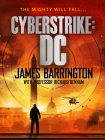Cyberstrike, James Barrington [short story to read .TXT] 📗

- Author: James Barrington
Book online «Cyberstrike, James Barrington [short story to read .TXT] 📗». Author James Barrington
And the pilot in America doesn’t even get involved with arguably the two most difficult phases of any flight – take-off and landing. Because both of these require instant responses to potential obstacles, the ability to steer the drone along a particular sequence of taxiways, to take account of the prevailing wind and to obtain clearance from the local controlling authority, these two parts of the operation are handled by a local pilot at whatever airfield or air base the drone is operating from. The pilot in America only takes over control once the aircraft is clear of the airfield and at altitude, and he hands back control well before the drone approaches the runway for landing.
The general consensus is that these devices are an extremely useful addition to the armoury of the United States of America, and the use of UAVs and UASs – unmanned aerial systems, a generic term usually applied to unarmed reconnaissance vehicles – has been increasing in recent years. In fact, it’s been increasing a lot.
It’s been established that there are over a thousand American military bases worldwide, and for a drone to operate from one doesn’t require anything like the infrastructure that would be needed to operate conventional manned aircraft. A fairly short concrete or tarmac runway, a small hangar or other building in which the drone can be kept and where maintenance work, refuelling and re-arming can take place, a handful of qualified pilots and maintainers and suitable communications, and that’s about it.
But as well as bases overseas located in or near potential or actual trouble spots, there are drone bases in at least thirty-nine of America’s fifty states and UAVs are an increasingly common sight to observers on the ground and an even more common sight to air traffic controllers sitting in front of radar displays. Not all of these drones are operated by the American military. American Customs and Border Protection use Predators to monitor the borders of the country, the Central Intelligence Agency operates a small fleet of UAVs for classified purposes – almost everything the CIA does is classified, obviously – and the Defense Advanced Research Projects Agency – DARPA – frequently flies drones over the continental United States.
What is perhaps more surprising is the range of organisations that possess Certificates of Authorizations or COAs that allow them to operate drones over America. These include police departments, colleges, universities and even a few towns and small cities. What characterises these UAVs, however, is the fact that they are unarmed and are normally used for tasks like surveillance, photographic reconnaissance and mapping missions.
Drones operated in the airspace above continental America by the military, on the other hand, are normally armed, and some of the bases used are in surprising locations. As is stated in this novel, two of them are in New York State. Syracuse, New York is the location of the Hancock Field Air National Guard Base, which operates Reapers, and fairly recently the American Army base at Fort Drum, also located in New York State, began training missions using Reapers, initially operated by qualified drone pilots from Hancock Field.
SSR Secondary Surveillance Radar
One common factor relating to drones flying in either military or civilian airspace is the requirement that they be identifiable, both to ground-based radar operators and to other aircraft. And, just like manned military and civilian aircraft, this identification is achieved by means of SSR – secondary surveillance radar – transponders. This word is an example of a portmanteau, a word made up from two other words, in this case ‘transmitter’ and ‘responder’, which is precisely how it functions.
The transponder receives an interrogation message on 1030 MHz and sends a reply on 1090 MHz. What it replies depends upon the type of aircraft it is fitted to. Military aircraft can transmit an IFF – identification friend or foe – signal, a coded message that can be read by military radar operators and fighter aircraft, while both military and civilian aircraft can transmit a code comprising 4,096 different options in the form of four digits that use the numbers 0 to 7, so 0000 to 7777. This code can be converted by a radar station using a system called code/callsign conversion to display the aircraft’s callsign, speed, and altitude if a Mode C transponder is fitted, along with its rate of climb or descent.
Within this allocation are certain reserved codes used to silently indicate the status of the aircraft, the most important of which are 7500 (hijacking), 7600 (radio failure) and 7700 (emergency), all of which are shown as enhanced returns on radar displays.
For drones, the carriage of SSR transponders is essential because many of these devices are too small to be seen with the naked eye until a mid-air collision might be unavoidable. The other side of the coin, obviously, is that flying a Reaper or a Predator over the badlands of Afghanistan with its SSR transponder unambiguously announcing its presence to any hostile unit equipped with a suitable radar and a truckload of SAMs is clearly a recipe for disaster, so the ability to remotely turn the transponder off and on is essential.
Hijacking or taking over a drone
It would be reasonable to expect that as the Predator and Reaper drones and their lethal kin are as well armed as a modern ground-attack aircraft, the designers and engineers would have ensured that their software was impossible to hack and made certain that their transmissions could not be intercepted or compromised. That expectation, sadly, has proved to be somewhat optimistic. The reality is that data transmitted from any device can be intercepted or jammed or disrupted in some way and this applies equally to an airborne drone and to its base station.
In December 2009 the Wall Street Journal published a headline that probably sent shivers down the collective spines of the American government and much of the





Comments (0)